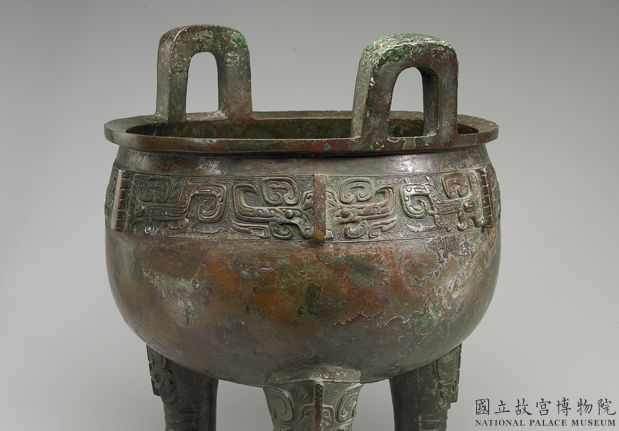Ding cauldron dedicated to Father Wu, late Shang period, c. 12th-11th century BCE
- Image Number: span>Material:Mineral/metal/bronze
- Description:
Slightly closed mouth, flat folding edge, Erect ears, tympanum, round bottom, column foot. The lower part of the mouth and the foot are decorated with animal face patterns, and the short leaf ridge is the nose in the middle of the animal face. The inscription is on the inner wall of the utensil, and there are three words in a subframe: “□. Father Wu”. “□” bronze inscriptions have been unearthed in Jingjie Shang Tomb in Lingshi, Shanxi (M1:11, M1:13). Triangular lines can be seen between the three feet on the outsole of this device, and there are light relief “moire” with thin lines in it, but the details are relatively simple. The appearance of animal images on the outer soles of bronze ware was popular from the late Shang Dynasty to the early Western Zhou Dynasty. It was mainly shown in the round ritual vessels such as zhi, zun, pot, and pan. Most of the patterns were dragon patterns, and others were phoenix patterns, cicada patterns, and turtle patterns

![图片[2]-Ding cauldron dedicated to Father Wu, late Shang period, c. 12th-11th century BCE-China Archive](https://chinaarchive.net/Shang dynasty/Bronzes/K1A002165N000000000PAC-1631.jpg)
![图片[3]-Ding cauldron dedicated to Father Wu, late Shang period, c. 12th-11th century BCE-China Archive](https://chinaarchive.net/Shang dynasty/Bronzes/K1A002165N000000000PAC-1632.jpg)
Pictures & Images [HD] download
© Copyright
The copyright of the article belongs to the author, please keep the original link for reprinting.
THE END





